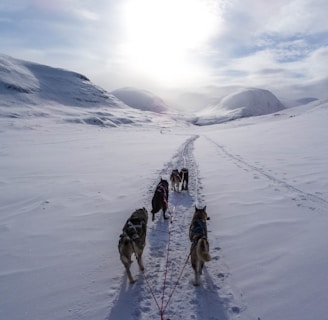Dog Breeds that Thrive in Year-round Snowy Environments
These breeds have developed unique characteristics, such as thick double coats, endurance, and strength, to withstand freezing temperatures and navigate through deep snow.
DOG LIFESTYLE
12/28/20233 min read


Many regions on Earth experience year-round snowfall, creating a winter wonderland that lasts throughout the year. In these snowy landscapes, certain dog breeds have adapted to thrive in the cold and harsh conditions, while others may struggle to survive. This article explores the dog breeds that are well-suited for living in areas with perpetual snow, highlighting their unique characteristics and abilities.
1. Alaskan Malamute
The Alaskan Malamute is a large and powerful sled dog breed that originated in Alaska. With their dense double coat, sturdy build, and endurance, these dogs are well-equipped to handle extreme cold and heavy snowfall. Alaskan Malamutes have a strong work ethic and were historically used for pulling heavy loads over long distances in Arctic conditions.
These dogs have a friendly and affectionate nature, making them great companions for families living in snowy regions. However, their high energy levels and need for regular exercise mean they require an active lifestyle and plenty of outdoor activities to keep them mentally and physically stimulated.
2. Siberian Husky
The Siberian Husky, another sled dog breed, is renowned for its ability to thrive in cold climates. Originating from Siberia, these dogs have a thick double coat that provides insulation against frigid temperatures. Siberian Huskies are known for their endurance, speed, and ability to pull heavy loads through deep snow.
These intelligent and friendly dogs have a strong pack mentality and are well-suited for families living in snowy environments. Siberian Huskies require regular exercise and mental stimulation to prevent boredom, as they are an active breed with a natural instinct for running and exploring.
3. Samoyed
The Samoyed is a beautiful and gentle dog breed that hails from Siberia. These dogs were historically used by the Samoyedic people for herding reindeer, pulling sleds, and keeping their owners warm during cold nights. Samoyeds have a thick, weather-resistant coat that helps them withstand freezing temperatures and heavy snowfall.
Known for their friendly and sociable nature, Samoyeds make excellent family pets in snowy environments. They are highly adaptable and can live comfortably in both rural and urban settings. However, their thick coat requires regular grooming to prevent matting and keep them clean.
4. Tibetan Mastiff
The Tibetan Mastiff is a large and powerful dog breed that originated in the Himalayan region of Tibet. These dogs were bred to guard livestock and monasteries in harsh mountainous conditions, including snowy terrain. Tibetan Mastiffs have a thick double coat, providing insulation against the cold and enabling them to adapt to extreme weather.
While Tibetan Mastiffs are known for their protective and independent nature, they can be loyal and affectionate companions. However, they require experienced owners who can provide consistent training and socialization. Due to their size and strength, Tibetan Mastiffs need ample space to roam and regular exercise to keep them physically and mentally stimulated.
5. Bernese Mountain Dog
The Bernese Mountain Dog is a large and sturdy breed that originated in the Swiss Alps. These dogs were historically used as working dogs on farms, pulling carts and herding livestock in snowy and mountainous regions. Bernese Mountain Dogs have a thick, weather-resistant coat that helps them withstand cold temperatures and snowy conditions.
With their gentle and friendly nature, Bernese Mountain Dogs make excellent family pets in snowy environments. They are known for their loyalty and love for children, making them great companions for families. However, their thick coat requires regular grooming to prevent matting and keep them comfortable.
Conclusion
In regions where snow covers the ground year-round, certain dog breeds have adapted to thrive in the cold and harsh conditions. The Alaskan Malamute, Siberian Husky, Samoyed, Tibetan Mastiff, and Bernese Mountain Dog are just a few examples of dog breeds that are well-suited for living in perpetual snow.
These breeds have developed unique characteristics, such as thick double coats, endurance, and strength, to withstand freezing temperatures and navigate through deep snow. Their friendly and sociable nature also makes them great companions for families living in snowy environments.
However, it's important to remember that every dog is an individual, and their ability to adapt to snowy conditions may vary. Proper care, regular exercise, and attention to their specific needs are essential to ensure the well-being of these breeds in snowy environments.
Subscribe to our newsletter
HEALTHY DOGGOS 2023 COPYRIGHT
